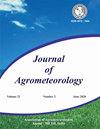Comparative analysis of two parameter-dependent split window algorithms for the land surface temperature retrieval using MODIS TIR observations
Q3 Agricultural and Biological Sciences
引用次数: 0
Abstract
MODIS Land Surface Temperature (LST) product is extensively used in agricultural studies like crop health assessment, soil moisture estimation, irrigation management, land use land cover change, air-temperature retrieval and crop water stress detection. Numerous studies have used Split Window (SW) algorithms to retrieve LST from MODIS TIR bands. Among them, some utilize Sensor View Angle Dependent (SVAD) or Columnar Water Vapor Dependent (CWVD) SW algorithms. Present study aims to make use of SVAD and CWVD SW algorithms and compare them to evaluate the LST retrieval accuracy over various land surface type. Theoretical accuracy assessment of the CWVD and SVAD algorithms demonstrates a good accuracy with the RMSE of 1.09K and 1.42K, respectively. The experimental retrieval of LST achieves exceptionally good accuracy, with a RMSE of 1.45K in the CWVD algorithm and 1.80K in the SVAD algorithm, particularly in heterogeneous regions. In homogeneous regions, the RMSE values are 1.14K in CWVD and 1.10K in SVAD. Both algorithms exhibit satisfactory accuracy; nevertheless, the application of these algorithms may vary in agricultural contexts. Based on the obtained results and the inclusion of required parameters, we have arrived at a conclusion regarding the superior performance of the SVAD compared to the CWVD for LST retrieval.比较分析利用 MODIS TIR 观测数据进行陆地表面温度检索的两种依赖参数的分割窗算法
MODIS 陆面温度(LST)产品广泛应用于农业研究,如作物健康评估、土壤水分估算、灌溉管理、土地利用土地覆盖变化、气温检索和作物水分胁迫检测。许多研究使用分割窗(SW)算法从 MODIS TIR 波段检索 LST。其中,一些研究采用了传感器视角依赖(SVAD)或柱状水汽依赖(CWVD)SW 算法。本研究旨在使用 SVAD 和 CWVD SW 算法,并对它们进行比较,以评估不同地表类型的 LST 检索精度。CWVD 和 SVAD 算法的理论精度评估结果表明其精度良好,均方根误差分别为 1.09K 和 1.42K。LST 的实验检索精度特别高,CWVD 算法的 RMSE 为 1.45K,SVAD 算法的 RMSE 为 1.80K,尤其是在异质区域。在同质区域,CWVD 算法的 RMSE 值为 1.14K,SVAD 算法为 1.10K。这两种算法都表现出令人满意的精确度;然而,这些算法在农业环境中的应用可能会有所不同。根据所获得的结果和所需参数,我们得出结论,在 LST 检索方面,SVAD 的性能优于 CWVD。
本文章由计算机程序翻译,如有差异,请以英文原文为准。
求助全文
约1分钟内获得全文
求助全文
来源期刊

Journal of Agrometeorology
农林科学-农艺学
CiteScore
1.40
自引率
0.00%
发文量
95
审稿时长
>12 weeks
期刊介绍:
The Journal of Agrometeorology (ISSN 0972-1665) , is a quarterly publication of Association of Agrometeorologists appearing in March, June, September and December. Since its beginning in 1999 till 2016, it was a half yearly publication appearing in June and December. In addition to regular issues, Association also brings out the special issues of the journal covering selected papers presented in seminar symposia organized by the Association.
 求助内容:
求助内容: 应助结果提醒方式:
应助结果提醒方式:


